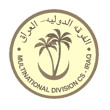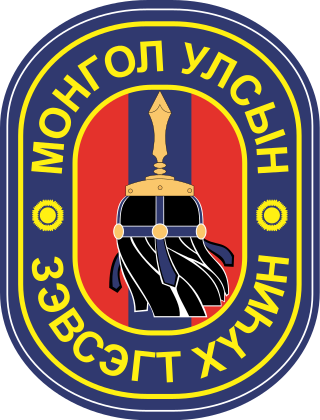
The Mongolian Armed Forces is the collective name for the Mongolian military and the joint forces that comprise it. It is tasked with protecting the independence, sovereignty, and territorial integrity of Mongolia. Defined as the peacetime configuration, its current structure consists of five branches: the Mongolian Ground Force, Mongolian Air Force, Construction and Engineering Forces, cyber security, and special forces. In case of a war situation, the Border Troops, Internal Troops and National Emergency Management Agency can be reorganized into the armed forces structure. The General Staff of the Mongolian Armed Forces is the main managing body and operates independently from the Ministry of Defence, its government controlled parent body.

Multi-National Corps – Iraq (MNC-I) was a formerly multinational, later U.S. only, army corps created on 15 May 2004, fighting the Iraq War. Its superior body, the Multi-National Force-Iraq (MNF-I) had replaced Combined Joint Task Force 7 on May 15, 2004. The change was made due to "concerns that had existed for some period of time, that the Combined Joint Task Force 7 headquarters was not sufficient to handle the range of military operations in Iraq, including peace support, civil military operations, and at the same time conduct strategic engagement such as talking to the sheiks and talking to the political authorities."

The Multi-National Force – Iraq (MNF–I), often referred to as the Coalition forces, was a military command during the 2003 invasion of Iraq and much of the ensuing Iraq War, led by the United States of America, United Kingdom, Australia, Italy, Spain and Poland, responsible for conducting and handling military operations.

Below is an estimated list of the major units deployed within the Multi-National Force – Iraq and other United States military units that were operating in Iraq under the U.S. Central Command (USCENTCOM) in 2009, during the Iraq War.
Multi-National Division (South-East) was a British commanded military division responsible for security in the south east of Iraq from 2003 to 2009. It was responsible for the large city of Basra and its headquarters were located at Basra Airport. The division was initially responsible for the governorates of Al Muthanna, Maysan, Basra, and Dhi Qar. MND-SE was a subordinate division of Multi-National Corps Iraq. Multi-National Corps Iraq was itself part of Multi-National Force-Iraq.

Polish–Ukrainian Peace Force Battalion (POLUKRBAT) or Ukrainian-Polish Peace Force Battalion (UKRPOLBAT) is a Polish-Ukrainian peacekeeping battalion, formed in the late 1990s expressly "for participation in international peace-keeping and humanitarian operations under the auspices of international organizations".

Operation Marne Torch refers to two operations launched by U.S.-led Coalition forces in 2007 against al-Qaeda in Iraq in the Arab Jabour area of Babil province. This campaign is named after Operation Torch, the joint US/British invasion of French North Africa in 1942, presumably because of the two operations' similar thrust into the enemies' southern underbellies.
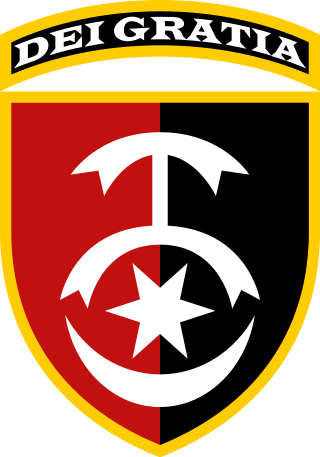
The 30th Prince Konstanty Ostrogski Mechanized Brigade is a formation of the Ukrainian Ground Forces. The full name of the unit is 30th Independent Mechanized Brigade "Konstanty Ostrogski".

The Polish zone in Iraq, designated as the South Central, South Center, Central South, Center SouthZone or Sector, was the area of responsibility for Multinational Division Central-South under Polish command, during the Occupation of Iraq. It was created in 2003 when Iraq was divided into four zones. The occupation ended on 31 December 2008.

The 6th Mechanized Brigade was a formation of the Ukrainian Ground Forces sent to Iraq in March 2004 to replace 5th Mechanized Brigade. Brigade was deployed from March 2004 to 22 September 2004.
Combined Joint Task Force 7 was the interim military formation that directed the U.S. effort in Iraq between June 2003 and May 2004. It replaced the Coalition Forces Land Component Command on 14 June 2003. CFLCC was the land forces component of United States Central Command that carried out the initial invasion of Iraq, was established by Commander, U.S. Army Forces Central Command, in 2002/3, to oversee two corps-sized organizations, I Marine Expeditionary Force and V Corps. These two corps-level formations carried out Operation Iraqi Freedom which began on 20 March 2003.
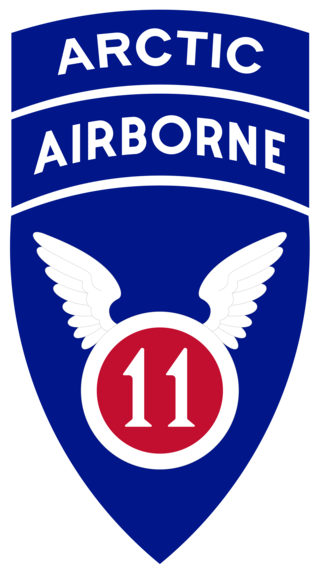
The 2nd Infantry Brigade Combat Team (Airborne), 11th Airborne Division is an airborne infantry brigade combat team (BCT) of the United States Army. The unit is stationed at Joint Base Elmendorf-Richardson in Anchorage, Alaska and is the only airborne brigade combat team in the Pacific Theater. It is also the newest airborne Infantry BCT and one of only five in the United States Army; the others are the three Infantry BCTs of the 82nd Airborne Division and the 173rd Airborne Brigade.
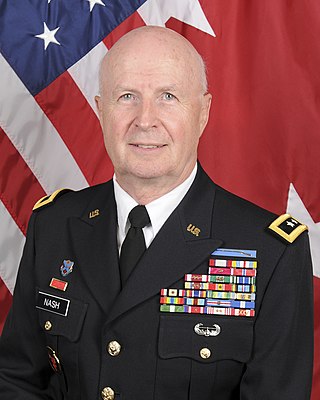
Lieutenant General (Brevet) Richard C. Nash was the 30th adjutant general of the Minnesota National Guard, having been appointed to that position by the governor of Minnesota in 2010. Nash had previously served as commanding general of both US Army and multi-national forces including the US Army's 34th Red Bull Infantry Division, the Multi-National Division-South during Operation Iraqi Freedom, and the Multi-National Brigade-North (SFOR-14) in Bosnia Herzegovina during Operation Joint Forge.

United States Forces – Iraq (USF-I) was an American military sub-unified command, part of U.S. Central Command. It was stationed in Iraq as agreed with the Government of Iraq under the U.S.–Iraq Status of Forces Agreement. USF–I replaced the previous commands Multi-National Force – Iraq, Multi-National Corps – Iraq, and Multi-National Security Transition Command – Iraq from January 2010. General Raymond T. Odierno initially served as commanding general but he was replaced by General Lloyd Austin in September of 2010. The logo of the USF-I depicts a lamassu.
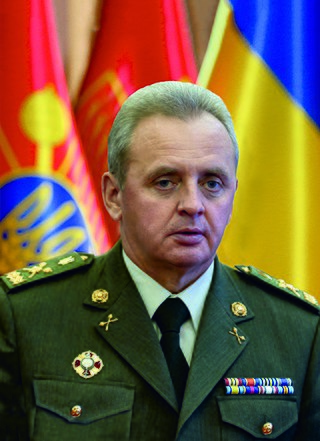
Viktor Mykolayovych Muzhenko is a Ukrainian general who was the Chief of the General Staff and the commanding officer of the Armed Forces of Ukraine from 2014 to 2019.

Enhanced Forward Presence (EFP) is a NATO-allied forward-deployed defense and deterrence military force in Northern, Central and Eastern Europe. This posture in Northern Europe through Estonia, Latvia, and Lithuania and in Central Europe through Poland, Slovakia and Hungary and in Eastern Europe through Romania and Bulgaria, is in place to protect and reassure the security of NATO's Northern, Central and Eastern European member states on NATO's eastern flank.
The Task Force 976 Thai-Iraq was a military unit of the Royal Thai Armed Forces, it was a part of the Multi-National Force – Iraq The Mission unit was Humanitarian Operation in Iraq, After the successful US invasion of Iraq, Thailand contributed 423 non-combat troops in August 2003 to nation building and medical assistance in post-Saddam Iraq.

KAZBAT refers to a peacekeeping military unit in the Armed Forces of Kazakhstan. It is an airmobile brigade of the Kazakh Air Assault Forces.
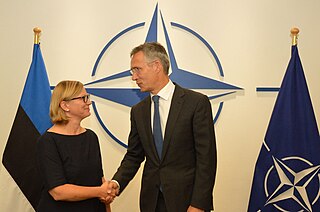
Since Estonia joined NATO in 2004, Estonia has participated in many joint military operations using its Estonian Defence Forces. Estonia has also participated in NATO-led military and peacekeeping operations before 2004.
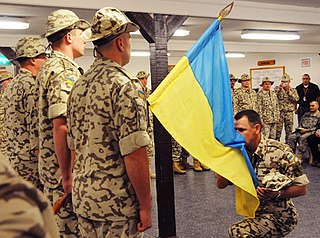
Ukraine began its involvement in the Iraq War on 5 June 2003, shortly after the 2003 invasion of Iraq. Throughout the conflict, Ukrainian troops were limited to a peacekeeping role, as part of the Multi-National Force – Iraq, though they engaged in combat with Iraqi insurgents. On 9 December 2008, Ukraine formally withdrew its last forces from Iraq, ending its participation in the Iraq War. Prior to the Russo-Ukrainian War, Ukraine's involvement in the Iraq War was the largest military operation ever performed by the Armed Forces of Ukraine. Over 6,000 Ukrainians performed military service in Iraq and Kuwait during the war, including a permanent presence of 1,600, and 18 Ukrainians were killed.
